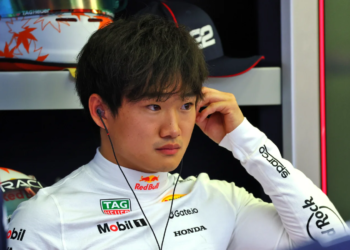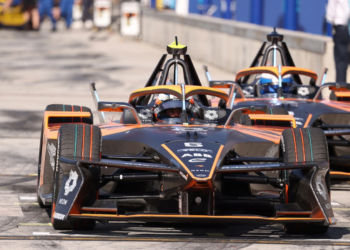In 2018 Haas finished a standout fifth in the Constructors’ Championship and through 2019 its VF-19 was firmly in the thick of the midfield. But it slumped to just ninth in the standings thanks to a litany of lacklustre race performances. What went wrong? Motorsport Week continues its end-of-year review by reflecting on Haas’ problematic campaign.
Eighth in 2016. Eighth in 2017 (with more points), and fifth in 2018. Haas’ trajectory through its infancy in Formula 1 has been impressively upwards. Its exploitation of the regulations to align itself with Ferrari and out-source work to Dallara was regarded as a cost-effective template for future F1 teams: the ability to be competitive on a relatively low budget. It ran Renault close. It beat McLaren. It would have taken an extraordinary 2019 for Haas to avoid a plateau but few anticipated such a dire slump. From 93 points and P5 to 28 points and P9. Its best year to its worst year.
During this website's sister publication Motorsport Monday's round-up of Barcelona pre-season testing we regarded Haas as likely contenders to lead the midfield again, for the seemingly obedient VF-19 caught the eye with its one-lap pace and race simulation. But a note of caution was added, as follows:
The caveat is the fact its predecessor, the VF-18, also worked well in Barcelona – and some other venues – but was less compliant elsewhere, amid struggles in getting the notoriously tricky tyres into the correct operating window. That led to fluctuating results (albeit still more consistent than 2016/17) and so pre-season testing across eight days of similar weather conditions at the same venue cannot tell us whether Haas has cured that particular weakness.
In Australia Haas was the quickest midfield car and had a pit stop disaster. Was this 2018 again, we wondered, for the outcome was eerily similar. In Bahrain the VF-19 was rapid once more over one lap… and then dramatically slumped down the order in the race. Kevin Magnussen was utterly shell-shocked post-race. He’d almost out-qualified Max Verstappen on Saturday but by Sunday was a “hopeless” P13. Magnussen, never the most expansive of drivers with the media, looked ashen-faced at what he had encounter. The situation was similar in China. Worse in Azerbaijan. By that point it was clear Haas had a fundamental problem.
.jpg)
“You go into the graining phase, and then when we go into the graining phase we cannot get out of it anymore because our tyre then gets too cold and then we are done,” said Guenther Steiner after the race in Baku. “Then we slide around.” At this stage it was felt that Pirelli’s capricious tyres were the root of the cause, but it transpired to be an effect of aero instability, a situation which was not realised for some time.
An aerodynamic package introduced at the Spanish Grand Prix did not work as expected and there were more several lacklustre race results and further confusion. Canada was a write-off, accentuated by Magnussen’s huge qualifying shunt, in-race radio moans, and Romain Grosjean’s Turn 1 contact, while the squad was completely anonymous in France. Magnussen qualified fifth in Austria but in the first stint of the race was battling the Williams drivers.
“What is bizarre to me… a car that was good enough to qualify seventh and eighth in the first race is then all of a sudden second-last,” said a baffled Steiner in France. “Don’t ask me what it is, I don’t know. Don’t ask me please because I wouldn’t know. We need to find out, it’s very disappointing, ending up in this situation but also not having an understanding of it, that’s the worst of it all… If you don't know that one [the problem], how can you work on solutions? Because you work on everything, then the best thing is you make a new car.”
.jpg)
That aerodynamic upgrade package introduced in Spain had not worked as expected, with Grosjean in particular complaining of chronic rear-end instability, and his persistent persuasion paid off. Haas, which later accepted it was too slow to listen to the drivers, resorted to running split specifications in Britain: Grosjean on his favoured Melbourne-spec, Magnussen on the newest version. But it was a season nadir. If the bizarre Rich Energy saga wasn’t bad enough – an unsavoury sideshow with an inevitable conclusion – Grosjean (who shunted in the pit lane in practice) and Magnussen clashed on the first lap, rendering the weekend a write-off. Steiner was understandably apoplectic.
Events in Germany, in which its drivers came perilously close to another disastrous clash, and Hungary gave Haas pointers but also more frustration. Its position in the pecking order fluctuated substantially, which showed the inherent pace in the car, the damage minor temperature changes enacted, and further clouded the direction which the team should take.
“It’s tough when you qualify P4 in Q1 to then not make it to Q3 is… every lap when you go out you have to learn a new car,” said Magnussen in Hungary. “It was literally one second slower from one run to another. Q1, run one, I did a 1:16.1, then Q2, run one, I did a 1:17.1. I didn’t have any mistakes or anything, you know, I just went through Turn 1 on that second run and felt no grip. You think ‘OK, I’ll make the best of this because maybe the track is worse and everyone is going slower, so try to get the best lap we can’. But it was one second slower, and no-one else went that slow. We get times where I’m one second faster than Romain – you know, I’m not one second faster than him – then we get other times when I’m half a second or a second slower.”
.jpg)
After the relatively anomalous events in Belgium and Italy, with low downforce required, Haas adopted a Melbourne-based hybrid approach for most of the remaining events, fitting an updated front wing and modified sidepods to the VF-19. It was an acceptance that mid-season updates had not worked. Undoubtedly having to focus on different specifications, aero work, and tyre experiments was not assisting the team’s individual weekend performances compared to its rivals, particularly in a closely-matched midfield group. But Haas stepped back and realised the bigger picture was not just about scrapping for points in 2019 but to understand how to dig itself out of the hole for 2020, particularly as by this stage it was all but set for ninth in the championship. An aspect of its status that has proved an advantage (low overheads, our-sourcing, a minimal headcount) were factors that then worked against it when it needed rapid gains. It simply didn’t have the resources or capacity to accelerate development. That a car not far off Melbourne specification could qualify in Q3 in Brazil spoke volumes of the unpredictable nature of the VF-19 – and where Haas has gone wrong. Fall into the right window and it was a midfield-beater. Fall out of it and… no chance.
“I think we just know that the wind tunnel to the track has been wrong,” said Grosjean in Russia in September. “So, it’s something that we tried to understand, where it’s coming from, as at the minute that’s the key, getting the delta to a decent level rather than staying where we are, which is a big correlation issue. I don’t think we’re lost, we know it’s somewhere in there, there’s been an acknowledgement of it. Is there a deadline? No. I think we’ve made some good step in understanding, from what I hear. I’ve got confidence that we will bounce back next year in a good way.”
For Magnussen and Grosjean it was a frustrating year spent largely away from the points-paying positions. Magnussen held the edge for much of the campaign, reflected in their head-to-head one-lap results and final standings, but both drivers had fine displays on occasion. Grosjean received plaudits, including from Magnussen, for his insistence that the Spain update had not worked and almost counter-intuitively a poor season aided his cause for being retained, with Haas keen to avoid unnecessary personnel changes that could create a variable. It briefly considered Esteban Ocon, who was ultimately Renault-bound, and weighed up the merits of Nico Hulkenberg, but preferred the status quo.
It is too soon to assertively conclude that Haas is on the right track for 2020. Even after Barcelona testing, and in Australia, it would be a rush to predict whether Haas has addressed its 2019 setbacks. This year was proof of that. In a world of rapid development and tricky tyres Haas fell frustratingly short. Next year it has to show progress while perfectly balancing its limited resources to avoid being left behind for 2021. It could be the biggest challenge yet for Formula 1’s newest outfit and act as a further test of its owner's gradually waning patience.
.jpg)






